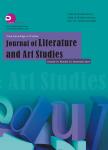
T=题名(书名、题名),A=作者(责任者),K=主题词,P=出版物名称,PU=出版社名称,O=机构(作者单位、学位授予单位、专利申请人),L=中图分类号,C=学科分类号,U=全部字段,Y=年(出版发行年、学位年度、标准发布年)
AND代表“并且”;OR代表“或者”;NOT代表“不包含”;(注意必须大写,运算符两边需空一格)
范例一:(K=图书馆学 OR K=情报学) AND A=范并思 AND Y=1982-2016
范例二:P=计算机应用与软件 AND (U=C++ OR U=Basic) NOT K=Visual AND Y=2011-2016

摘要:This paper delves into Anton Chekhov's The Seagull and George Bemard Shaw's The Apple Cart to extensively analyze their infusion of certain comical elements in depicting ostensibly tragic concerns. The paper aims at exploring the use of the comic elements that is not without purpose. Instead through this incorporation of farce, linguistic humor, witty repartee and exaggeration, the holistic vision of life is obtained which was earlier compartmentalized by the Greeks and Roman playwrights. Comic elements including slapstick humor, the singing of songs, and certain character portrayal are discussed as techniques employed at the hands of the playwrights to reflect over the real historical milieu of their respective times, yet giving a boost to realism as a theory and a practice. This is a qualitative study based upon hermeneutic theory of textual analysis. The paper establishes the similarities in Bernard Shaw's and Anton Chekhov's employment of comical elements as well as the difference between their essential purposes in generic transgression. Although the two writers have their roots in different countries, their humorous portrayal of various issues is seen to be similar. From the microanalysis of these plays, the same comic strains can be traced out in modern drama at macro level that will enhance the implication of this research paper. This paper therefore concludes that comic and tragic elements are not antagonistic rather complimentary to each other.
地址:宁波市钱湖南路8号浙江万里学院(315100)
Tel:0574-88222222
招生:0574-88222065 88222066
Email:yzb@zwu.edu.cn

